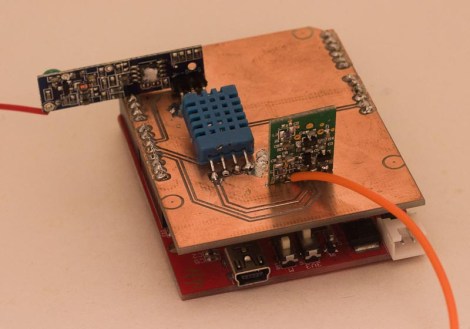
The apartment [Angus] lives in must be sealed up pretty tight. It was so humid during the winter that there was a mold issue. We usually have the opposite problem, needing to add humidity to the air in the colder months. To combat the issue he bought a small dehumidifier, but wanted to automate the system a bit more than what was built into its meager controls. He combined a set of wireless sensors and remote control outlets to switch the dehumidifier automatically.
The sensors are from a weather station he bought on eBay. It came with a base station and three remote units, all of which monitor both temperature and humidity. He wanted a system that could compare temperature with dew point and make decisions based on a simple look-up table. An Arduino with a custom milled shield reads these measurements from the sensors and feeds them to a router which is running a cron job script every minute. When that script judges the time and weather conditions warrant a change it tells the Arduino to switch the wireless outlet to which the dehumidifier is connected.














Not sealed up. He showers without the Vent fan running or a window open. You are dumping GALLONS of water into the apartment when you shower or cook without a vent fan that is piped outside running during and 10 minutes after the high humidity creating event.
Most apartments are built horribly and dont have real vent fants that exhaust outside.
This is pretty much it. Venting the bathroom to the outside world is hard, the extraction fan just dumps air into the ceiling space and the windows are a nightmare to get closed again.
Worse, our autumn & early winter (I’m in the southern hemisphere) were particularly wet and we realised drainage on our block goes partially via our place (we’re on the ground floor.)
If I owned it, I would do something about the underlying problems, but for a rental even buying a dehumidifier seemed like a big investment. :)
I don’t know what the style of your apartment is, but you might consider building a surface mounted exhaust system into your bathroom/apartment.
I built a ceiling mounted box that housed a Panasonic square exhaust fan (very quiet and very slim depth meant to mount in shallow spaces). Power ran through a conduit to a surface mount switch box (which i put a motion/occupancy sensor in) and then to a pig-tailed cord which plugged into the wall.
I ran metal ducting along the ceilings/walls to a near-by window which I reconfigured such that the top sash would always be lowered by approx. 4″ (imagine the “window” part of a portable air conditioner, like that, only a bit more permanent using a few brackets and copious amounts of DAP “Seal n’ Peel” removable sealant).
Now in my case the design of the apartment allowed this to work aesthetically and functionally–it was brick interior for outside walls so the “industrial look” of having exposed metal pipe was not too bad. There was also already an opening (covered by a grate on each side) between the bathroom and the main part of the apartment (this was the building owner’s attempt to help exhaust steam/etc from the room and also get heat into the bathroom which had no heater of its own–but all the opening ever did was just dump humidity into the rest of the place, and also made for very awkward bathroom trips with company over since the opening allowed sound (and smells) to travel very easily).
Assuming you have no hole in your bathroom wall, you might consider placing your fan box above the bathroom door and leaving the door open a bit when showering. You could also consider running the the ducting along the floor, though shortest distance and least number of angles is the best!
I lived in a house with super high humidity during the winter(condensation on walls, mold, etc.). Turned out the natural gas furnace was venting into the house/basement because the chimney was blocked. We had tried installing a shower vent fan thinking that was the problem. No effect. Discovered the blocked chimney by accident. It’s amazing we didn’t die. Might be worth checking. After we fixed the chimney the gas bills were much higher, and the house was terribly dry.
Incorrect or damaged venting of gas appliances is why CO detectors are now required in the US. It’s too easy to die or become seriously ill from something silly like this.
Required? Citation, please.
I have two CO detectors in my house. I bought them because I wanted them, not because someone else forced me to do so.